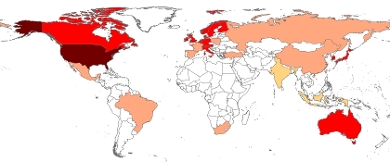Onderzoeksproject
Footprint family: Concepts, classification, integration, and benchmarking against planetary boundaries
How to bring together different footprints into an integrated family and what are the synergies? What are the roles of inventory analysis and characterization in measuring individual footprints and how these affect a footprint family? How to benchmark environmental footprints against related planetary boundaries and why this represents an evolution from environmental impact assessment to environmental sustainability assessment.
- Looptijd
- 2011 - 2015
- Financiering
-
 This project is financially supported by China Scholarship Council
This project is financially supported by China Scholarship Council
Short abstract
Starting from the idea of providing an overall picture of the impacts of anthropogenic activities on the planet’s environment, this PhD project brings together various environmental footprints into a footprint family which is further benchmarked against planetary boundaries from a systemic perspective. Its aim is to break down disciplinary barriers and to offer novel insights into environmental sustainability assessment.

Global-scale national footprints
Project description
Sustainability science needs interdisciplinary views and integrated approaches. Our work challenges the isolation of footprint analysis and planetary boundaries as two independent fields of research and makes use of both in a complementary way.
Material & Methods
The ecological, energy, carbon and water footprints are selected to constitute a footprint family, where the combined effects of the four footprints are evaluated. A parallel with the downscaling of planetary boundaries to the national level allows for comparison of current environmental conditions and critical capacity thresholds.
Results & Conclusions
The footprint family investigated is able to offer a more complete picture of environmental impacts for policy makers, particularly if based on a scientific impact characterization basis. A footprint-boundary environmental sustainability assessment framework has been established, with applications in greenhouse gas emission, water use and land use for major nations of the world.
Why Leiden University?
Leiden is a prestigious university with historical, world-wide reputation. CML is an elite research institution at the forefront of environmental and ecological sciences, particularly in the area of life cycle assessment which is a key methodology for footprinting.
- Fang K, & Heijungs R. (2015). The role of impact characterization in carbon footprinting. Frontiers in Ecology and the Environment, in press.
- Fang K, Heijungs R., & de Snoo, G. R. (2015). Understanding the complementary linkages between environmental footprints and planetary boundaries in a footprint-boundary environmental sustainability assessment framework. Ecological Economics, in press.
- Fang, K., & Heijungs, R. (2015). Rethinking the Relationship between Footprints and LCA. Environmental Science & Technology 49: 10-11
- Fang, K., Heijungs, R., & de Snoo, G. R. (2014). Theoretical exploration for the combination of the ecological, energy, carbon, and water footprints: Overview of a footprint family. Ecological Indicators 36: 508-518.
- Fang, K., & Heijungs, R. (2014). Moving from the material footprint to a resource depletion footprint. Integrated Environmental Assessment and Management 10: 596-598.
- Fang, K., & Heijungs, R. (2014). There is still room for a footprint family without a life cycle approach—Comment on “Towards an integrated family of footprint indicators”. Journal of Industrial Ecology 18: 71-72.
- Fang, K., Heijungs, R., & de Snoo, G. (2013). The footprint family: comparison and interaction of the ecological, energy, carbon and water footprints. Revue de Métallurgie 110: 77-86.
